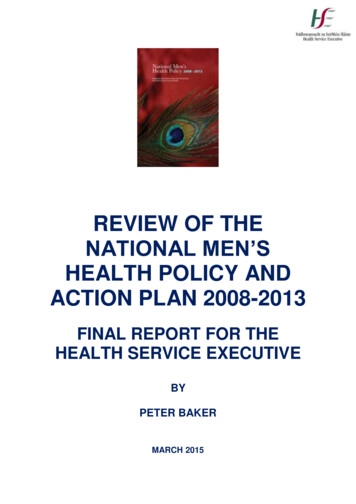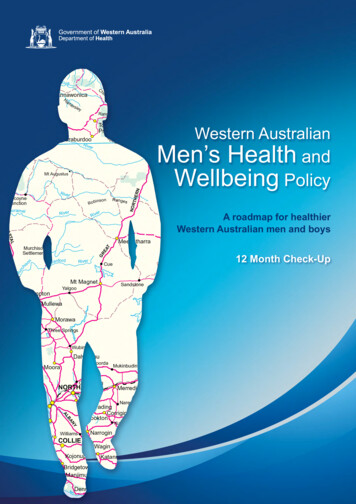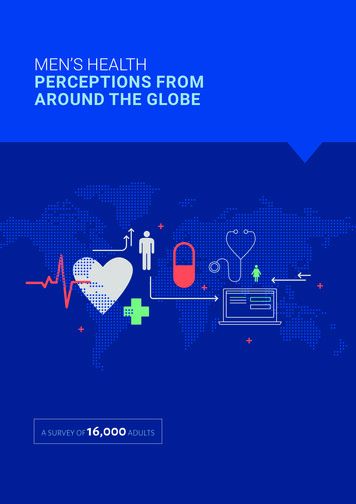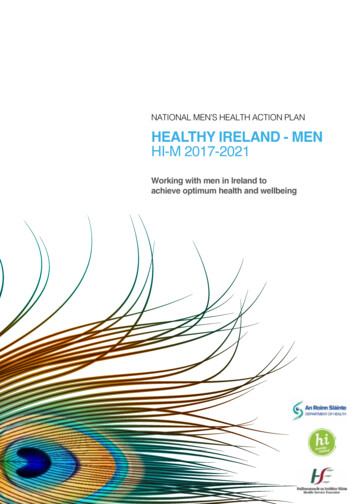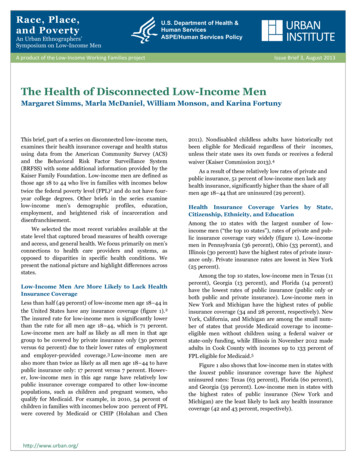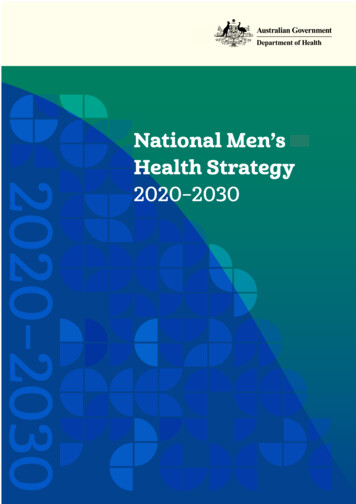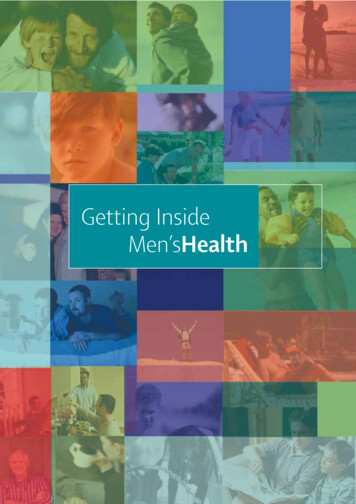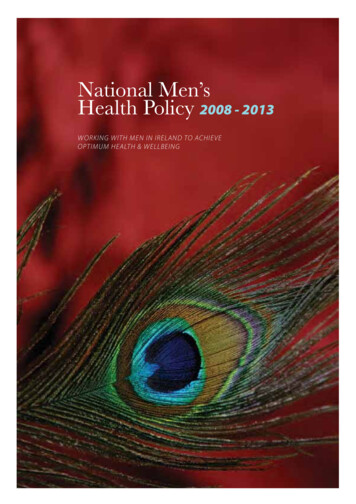
Transcription
National Men’sHealth Policy 2008 - 2013WORKING WITH MEN IN IRELAND TO ACHIEVEOPTIMUM HEALTH & WELLBEING
Copyright Minister for Health and Children, December 2008Department of Health and ChildrenHawkins HouseHawkins StreetDublin 2Tel: 353 (0)1 635 4000Fax: 353 (0)1 635 4001E-mail: dohc@health.gov.ieWeb: www.dohc.gov.iePublished by The Stationery Office, DublinISBN 0-7557-7621-6All rights reserved. No part of this publication may bereproduced, stored in a retrieval system, or transmitted,in any form or by any means, electronic, mechanical,photocopying, recording or otherwise, without the priorpermission in writing of the copyright holder.For rights of translation or reproduction, applications should bemade to the Department of Health and Children,Hawkins House, Hawkins Street, Dublin 2, Ireland.30-01 11/08 (1,000) Brunswick Press Ltd. (22058)
ContentsForeword . viiAbbreviations . viiiExecutive Summary . 1Impetus for policy development .1Vision for men’s health in Ireland .1Research and consultation .3Key Policy Areas .3Policy Recommendations.8PART I: BACKGROUND AND POLICY CONTEXT1.Introduction . 151.1 Why focus on men’s health? . 151.2 Responding to men’s changing roles in Ireland . 151.3 Defining ‘men’s health’. 161.4 Impetus for policy development . 171.5 Meeting the challenges of addressing men’s health in the future . 182.Theoretical and philosophical principles underpinning the Men’s Health Policy . 192.1 Adopting a gendered and gender-relations approach . 192.2 Adopting a social determinants approach . 202.3 Adopting a community development approach .212.4 Adopting a health promotion, preventative approach . 212.5 Adopting an intersectoral and interdepartmental approach . 222.6 Tackling men’s health from a strengths perspective . 222.7 Supporting men to become more active agents and advocatesfor their own health . 233.Methodology for developing a men’s health policy in Ireland. 254.Key statistics on men’s health in Ireland . 294.1 Life expectancy . 294.2 Mortality . 314.3 Morbidity. 344.4 Health-related behaviours . 354.4.1Harmful use of alcohol . 354.4.2Smoking . 354.4.3Illegal drug use . 354.4.4Physical activity and diet – Overweight and obesity . 354.4.5Sexual health behaviours and sexually transmitted infections . 364.5 Risk behaviours . 364.6 Violence among men and domestic violence . 364.7 Summary . 37iii
Contents (continued)PART II: FRAMEWORK FOR NATIONAL MEN’S HEALTH POLICY IN IRELANDiv5.Strengthening public policy on men’s health . 415.1 Structures to support an integrated and intersectoral approach to men’s health. 415.1.1Challenges facing men’s health policy . 415.1.2Overcoming the challenges . 425.1.3Conclusions and Recommendations . 465.2 Research and information . 465.2.1Strengthening the evidence base on men’s health in Ireland . 475.2.2Translating research into policy and practice. 475.2.3Conclusions and Recommendations . 486.Promoting men’s health: Marketing, health information and programmes . 496.1 Marketing men’s health . 496.1.1Challenging contemporary stereotypes of men and masculinity . 496.1.2Promoting a more positive and holistic image of men’s health . 506.2 Targeting health information to men . 506.3 Health promotion programmes for men . 516.3.1Diet and physical activity – Overweight and obesity . 526.3.2Stress management . 546.3.3Harmful use of drugs . 556.3.4Sexual health behaviours. 586.3.5Risk behaviours . 596.4 Reaching men with health promotion programmes . 606.5 Conclusions and Recommendations . 617.Promoting gender-competency in the delivery of health and social services. 637.1 Provision of training in the area of men’s health . 637.2 Increasing men’s participation in education and caring professions. 647.2.1Primary teaching . 647.2.2Social care . 647.3 Conclusions and Recommendations . 658.Building gender-competent health services with a focus on preventative health. 678.1 Need for more gender-competent primary care services . 678.1.1Understanding why men tend not to use primary care services . 678.1.2Primary care and community-based men’s health checks andscreening initiatives . 698.2 Need for more gender-competent cancer preventative measures andscreening services . 708.2.1Cancer prevention . 708.2.2Cancer screening . 718.3 Need for more gender-competent mental health services . 728.4 Need for more gender-competent sexual health services. 728.5 Conclusions and Recommendations . 739.Developing supportive environments for men’s health . 759.1 The home as a setting for men’s health . 759.1.1Understanding the influence of relationships on men’s health. 759.1.2Men as fathers . 76
9.1.39.1.49.1.59.1.69.29.39.410.Men as carers . 79Men residing in sub-standard living conditions . 79Men and domestic violence . 79Conclusions and Recommendations . 80The education environment – schools and third-level colleges . 819.2.1The development of healthy masculinities among boys . 829.2.2Gender differences in learning and development. 839.2.3The need for improved links between school and home/community. 839.2.4Early drop-out rates for boys and second-chance education . 849.2.5Bullying . 859.2.6Adopting a gendered approach to male college students’ health . 859.2.7Conclusions and Recommendations . 86Promoting men’s health in the workplace . 879.3.1Improving productivity and reducing absenteeism . 889.3.2Work–life balance . 899.3.3Health and safety . 899.3.4Loss of work and the impact on men’s health . 909.3.5Stress in the workplace . 919.3.6Bullying in the workplace . 919.3.7Conclusions and Recommendations . 92Social spaces as a setting for men’s health . 939.4.1Safe social and recreational spaces for young people . 949.4.2Recreation and leisure facilities for all men . 959.4.3Conclusions and Recommendations . 96Community Development – Strengthening community action to supportmen’s health. 9710.1 Community development for men’s health . 9810.2 Approaching community development work for men .10110.2.1Engaging with men .10110.2.2Nature of work done within communities .10210.2.3Working exclusively with men .10210.3 Facilitating community development work with men .10310.4 Conclusions and Recommendations .104PART III: ACTION PLAN FOR NATIONAL MEN’S HEALTH POLICY 2008 – 201211.Action Plan for implementation of National Men’s Health Policy 2008 – 2012. 107Bibliography . 127Appendix 1: Membership of Steering Committee Men’s Health Policy . 153Appendix 2: Areas in need of further research in men’s health . 155v
ForewordThe publication of this National Men’sHealth Policy is a significant and importantstep in promoting optimum health andwell being for all men in Ireland. The casefor an increased focus on men’s health iscompelling. Men die, on average, almostfive years younger than women do andhave higher death rates at all ages, and forall leading causes of death. The burdenof ill-health and premature mortality isborne, in particular by men from the lowersocio-economic groups. There has been adisturbing increase in suicide rates amongmen in recent years, with suicide amongyoung men being particularly high.Despite traditionally being to the forefrontof health service policy and provision,men have tended to be more reticentin terms of advocating or speaking outabout their own health.This policy has been developed followingan extensive research and consultationprocess. The need for a specific policyfocus on men’s health was identified inthe National Health Strategy in 2001.This prompted the Department of Healthand Children to fund a three-year men’shealth research project, the findingsof which, Getting Inside Men’s Healthwere launched at the first NationalConference on men’s health, which tookplace in Wexford in December 2004. Aninter-Departmental and multi-sectoralSteering Group was appointed to overseethe development of the policy. Underthe terms of reference of the SteeringGroup, an extensive and nationwideconsultation process was undertaken withall relevant stakeholders. The findingsfrom this consultation process, togetherwith an extensive review of the evidenceunderpinning the issues raised, werethen translated into concrete policyrecommendations and actions. Theserecommendations and actions address abroad range of men’s health issues andhave implications in terms of gendermainstreaming men’s health across anumber of government departments. Itshould be stressed that targeting men’shealth can impact not just on men’s lives,but can have positive spin-offs on the livesof women and children.This policy will appeal to a wide audience– policy makers, service providers,health and allied health professionals,and to those who work with men in thecommunity and voluntary sectors. Thepolicy provides a clear blueprint and anunequivocal evidence base for tacklingmen’s health in the years ahead.Noel Richardson PhD (Author)Paula Carroll PhD (Author)vii
AbbreviationsviiiCRCcolorectal cancerCVDcardiovascular diseaseGMSGeneral Medical ServicesHSAHealth and Safety AuthorityHSEHealth Service ExecutiveICGPIrish College of General PractitionersIDGInter-Departmental GroupIoTIInstitutes of Technology IrelandISCIrish Sports CouncilIUAIrish Universities AssociationLDTFLocal Drugs Task ForceOMCYAOffice of the Minister for Children and Youth AffairsSEGsocio-economic groupSPHESocial, Personal and Health Education
Executive SummaryImpetus for policy developmentIn recent years, there has been a growing awareness, and indeed concern, about theburden of ill-health experienced by men in Ireland.[1, 2] Male life expectancy is almost 5years lower than female life expectancy[3] and men in Ireland have higher death ratesfor most of the leading causes of death across the lifespan[4-6]. The burden of ill-healthand mortality is borne, in particular, by men from the lower socio-economic groups(SEG 5 and 6). These men are up to 6 times more likely to die from the leading causes ofdeath than men from SEG 1.[68] Young men (aged 18-35 years) are also a high-risk group– they are almost 4 times more likely to die earlier than their female counterparts[8] andcurrently have the second highest rate of suicide among the 30 OECD Member States[9].The profile of men’s health has been raised internationally in recent years through anumber of key mechanisms. These include the hosting of the first World Congress onMen’s Health in 2001, the launch of the International Society for Men’s Health (ISMH),the commencement of an international Men’s Health Week, the launch of the EuropeanMen’s Health Forum (EMHF) and the introduction of three academic journals devotedto men’s health (International Journal of Men’s Health, Journal of Men’s Health and Genderand American Journal of Men’s Health).The upsurge of interest and activity around men’s health at international level has alsobeen mirrored in Ireland. In 2001, men were identified for the first time in the NationalHealth Strategy, Quality and Fairness[55], as a separate population group for the strategicplanning of healthcare. Specifically, Action 15 of the National Health Strategy called forthe development of ‘a policy for men’s health and health promotion’, which is the firstcall of its kind internationally. This significant step has enabled men’s health in Irelandto be greatly strengthened in recent years by research, advocacy work and a varietyof grassroots projects in both the statutory and community/voluntary sectors. TheHealth Service Executive (HSE) has funded research initiatives into men’s health[1, 2], hasdeveloped a number of regional strategies on men’s health[36-38] and has funded a rangeof community development-related projects for men’s health throughout the country.Other statutory and voluntary bodies have also supported research and initiatives onmen’s health, both locally and nationally.[2, 39-42, 122]All these initiatives have generated a considerable momentum in the area of men’shealth in Ireland and this momentum, from grassroots to statutory levels, has been a keyfactor in the development of this National Men’s Health Policy 2008 – 2013.Vision for men’s health in IrelandA number of key theoretical and philosophical principles have been adopted indeveloping this policy, each of which is discussed below.1
Adopting a gender-mainstreaming approachThis policy adopts a gendered approach to men’s health and recognises gender inthe context of culturally defined masculine or feminine traits that are deemed to besocially appropriate to the sexes.[43] A ‘gender-mainstreaming’[33] approach recognisesthat gender equality is best achieved through the integration of the health concerns ofmen and women in the development, implementation and evaluation of policies, bothwithin and beyond health. Building on the Equal Status Acts 2000 to 2004, this policyendorses the approach taken by Health Canada’s Gender-based Analysis Policy[34] and theEqual Opportunities Commission’s Gender Equality Duty Code of Practice[35] in Englandand Wales, and adapts these policies as potential frameworks from which to developa gender-mainstreaming approach to men’s health in Ireland, across all Governmentdepartments, in the future.Adopting a social determinants approachThis policy adopts a social determinants[48] approach to defining men’s health. Itrecognises that social and economic factors, including poverty, are key determinants ofthe health status of men.[7] The policy aligns itself with existing strategies[49, 50] that targetthe reduction of poverty in Ireland and that seek to tackle health inequalities by workingin partnership with National Anti-Poverty Networks and the Community DevelopmentProgramme. By recognising diversity within men, this policy acknowledges the right ofall men in Ireland to the best possible health, irrespective of social, cultural, political orethnic differences.Adopting a community development approachIn recognition of the fact that one’s community, defined by geography, culture orsocial stratification, is a valuable resource for health, this policy seeks to harness socialcapital among communities of men through a community development approach. Byadopting this approach to men’s health and positioning this policy within the widersocial inclusion policy of Government[49, 50], all communities of men in Ireland may besupported to achieve optimum health and well-being.Adopting a health promotion, preventative approachIn the context of supporting health behaviour change and reducing prematuremortality among men in Ireland, this policy calls for a gendered approach to theimplementation and evaluation of health promotion policy in Ireland.[57] It centres onthree core areas – settings (e.g. workplace), populations (e.g. young men) and topics(e.g. smoking cessation) – whereby lifestyle modification is targeted via key settings andtopics through a life stage approach.[304]National Men’sHealth Policy2008 - 20122Adopting an intersectoral and interdepartmental approachUnder the aegis of the Advisory Health Forum, this policy seeks to promote men’s healthin synergy with other policies and services within and beyond the health sector. Such anapproach calls for the strengthening of alliances and partnerships with the communityand voluntary sectors, as well as with the statutory sector in areas such as education,employment, environment and social affairs.
Tackling men’s health from a strengths perspectiveThis policy endorses a positive and holistic approach to men’s health – one thataddresses the underlying causal factors that can be attributed to men’s poorer healthoutcomes and that creates health-enhancing environments for boys and men. While itis imperative not to overlook the ‘problems’, it is equally important to build on the manystrengths of men in Ireland and to challenge men to take increased responsibility fortheir own health. This policy does not seek to make men dependent on the healthcaresystem, but rather to facilitate them in looking after themselves and in their use ofappropriate services for better health and quality of life.Supporting men to become more active agents and advocates for their own healthThis policy sets out a range of initiatives, in the statutory, community and voluntarysectors, designed to support men in becoming better advocates for their own health.Research and consultationA multi-level approach, centred around research and an extensive consultation process,was adopted for the development of this policy and its implementation, set out in theAction Plan in Part III of this policy document.[60] A research project was conductedwith more than 600 men over a 3-year period (2002-2004) to explore specific healthissues. The findings of this research[1] were launched at the first National Conference onMen’s Health, held in Wexford in December 2004, attended by over 150 delegates. Theoutcomes from this conference were also documented and used to inform this policy.An extensive consultation was then conducted over an 11-month period during 2005,involving 500 stakeholders from a diverse range of organisations to individual men.The consultation comprised three distinct phases (6 men’s health days, organised intoworkshops; 7 focus groups; and a call for submissions from the public and 94 targetedinvitations). In addition, an extensive review of both the national and internationalliterature on men’s health was conducted to establish the efficacy of translating theissues raised into policy recommendations. Other issues that emerged from the widerliterature were also considered for inclusion in this policy.Key Policy AreasStrengthening public policy on men’s healthThe successful implementation of this policy needs to take account of the factorsthat have impeded men’s health reaching policy agendas in the past. It is importantthat the structures underpinning the policy are developed in accordance with bestpractice in relation to policy development[60] and that they reflect the wider theoreticaland philosophical framework that underpins this policy. In order to ensure that thetargets set out in the men’s health policy can be achieved, the necessary structures andresources will need to be put in place, together with appropriate re-orientation andintegration of existing services.3
This policy identifies the need to broaden and expand the research base on men’shealth in Ireland. A crucial first step in this regard is the development of a National Men’sHealth Research Framework and Network within the context of the existing NationalPopulation Health Research Framework. In order to facilitate this, it is proposed thata Centre for Research and Development in Men’s Health be established, to be run onan initial pilot basis for 3-5 years. It is proposed that the Centre would be based in anacademic institution (the housing costs to be borne by the institution) and that externalfunding would be sought for two research posts and a ‘start-up’ research budget. Onceestablished, the proposed Centre would actively compete for research funding fromexisting sources in which research funds are disseminated, including the NationalPopulation Health Research Framework. It is imperative that the Centre would developclose working links with local HSE and community/voluntary agencies.Promoting and marketing men’s healthThere is a need to devise promotional and marketing strategies and programmes formen’s health that both challenge and support traditional notions of masculinity – inother words, developing health messages that appeal to men by challenging them totake greater responsibility for their own health so that they will be able to fulfil theirtraditional support role as provider, protector, husband and father. This policy endorsesthe recommendations from previous national health strategies[55, 118, 120] on the need
The profile of men's health has been raised internationally in recent years through a number of key mechanisms. These include the hosting of the first World Congress on Men's Health in 2001, the launch of the International Society for Men's Health (ISMH), , ).

